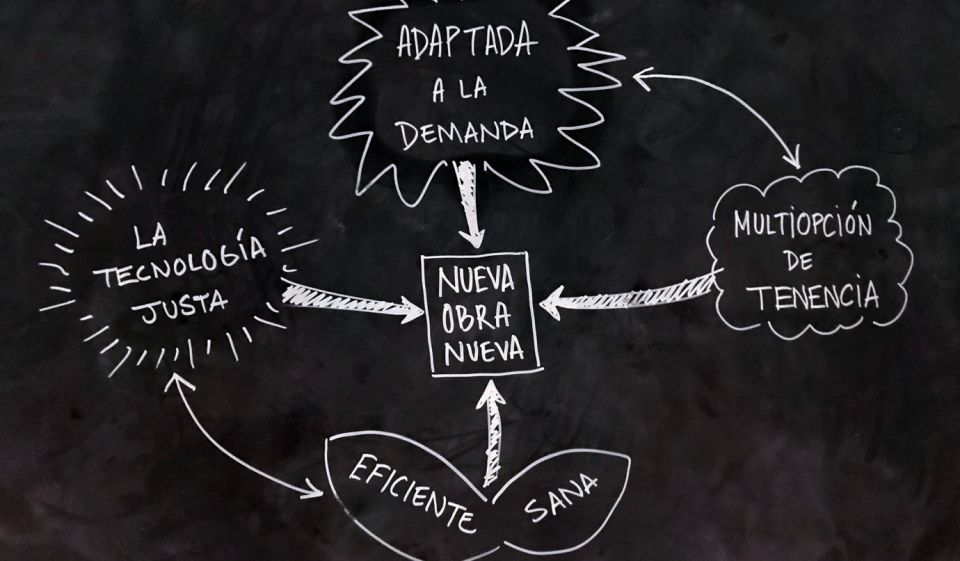For a new new work (part II)
An innovative approach to create more accessible, sustainable housing that is adapted to what we really need today and tomorrow.

Introductory note: No distinction is made in this article between new construction corresponding to new buildings and new construction resulting from major refurbishment operations.
In the first part of this article (For a new work part I) concluded by summing up the situation:
(1) Cities such as Barcelona offer a residential stock that is on average 70 years old.
(2) This housing is at the limit of what a growing, resigned and residentially conservative demand can afford.
(3) Meanwhile, housing producers, constrained by regulations and feeling comfortable in an undemanding market, replicate the same building over and over again with small incremental improvements and stylistic tweaks decided by
(4) Architects relegated to the role of advisors of image.
And it said:
It is therefore a combination of socio-demographic factors, supply and demand balance and pernicious sectoral inertia. All these factors play in favour of those who buy a home not demanding better and more suitable to their time and need of use. But what exactly is the substance of this "better and more suitable to their time and need of use"?
(Continued with Part II)
In my opinion, in the following (in order of relevance):
1. A house completely adapted to the demand This means that new building producers must stop promoting without asking the market what it wants.
The fact that more than 50% of property development in cities such as Barcelona is carried out by small developers or that the average size of a development is between 12 and 15 units makes it difficult to standardise market studies. ad hoc. The professionalisation of developers, geolocation database tools and the presumable emergence of specialised real estate consultancies anticipate a solution.
2. An energy-efficient and healthy home. An issue that has already been dealt with at length and to which I will only add that it should not be a factor to be decided by the demand side as its application is in the public and global interest.
3. Housing with just the right degree of applied technology as standard which will need to incorporate (1) home automation to ensure efficient behaviour and (2) infrastructure to enable the deployment of the IoT ecosystem.
4. Housing with multiple tenure options beyond ownership and renting, such as shared ownership, temporary ownership -both possible in Catalonia since 2015 [of which Professor Sergio Nasarre, director of the UNESCO Chair in Housing at the Universitat Rovira i Virgili, has spoken at length-, the right of use, usufruct or some of the forms of collaborative housing.

Each of the constituent attributes of what should be the new building work customer-oriented, sustainable and healthy, with the right technology, multi-accessible - will merit further reflection in a future article.
So far we have talked about where we are starting from and where we are going. To get from one to the other would require a strategic plan which, in my opinion, should be co-designed by all stakeholders. That's why it's not up to me to decide (nor would I know how!), but at this point and for the sake of debate, I'll risk proposing the roadmap of an "ideal plan" for the city of Barcelona that calls on each of the actors who should be part of this story.
The sequence of events would be as follows:
1. Choosing the right time in the business cycle to ensure that everything is in place at the end of the adjustment phase of the cycle.
2. Creation of "Barcelona branded" land through densification by way of (1) increases in maximum regulatory height and buildable ceiling [...].here there is an interesting debate on this point], and (2) the construction of the Greater Barcelona [here a well-argued synthesis], the "dense city and extensive city" enunciated by Pasqual Maragall 30 years ago. I insist on the idea of the "Barcelona brand", which I understand as an umbrella brand under which all the municipalities are nested, with specific attributes with an edge and common strategy.
[Barcelona and L'Hospitalet would be to Greater Barcelona what Volkswagen and Audi are to Volkswagen Group].
3. A Municipal Housing Plan whereby, for example, new land made available to developers is subject in whole or in part to alternative forms of tenure. This can be complemented by public-private co-development housing programmes and is based on the need for developers to accept that part of their business is "reduced profit". [In this regard it is worth looking at the work done by the developer Omplim in the first and second ring of Barcelona] and that Barcelona City Council understands that this is subject to risk reduction (increased political and regulatory certainty).
4. Creation of an instrument/entity for the promotion of new R&D&I new works: Developers, APCE, COAPI, Barcelona City Council, architecture schools and representatives of the construction industry must work together with a common long-term vision. Perhaps a similar initiative already exists.
5. From a net optimism and the freedom granted to me by the role, I will say that if the above were possible, the rest - with the permission of the United States, China, the United Kingdom, Syria, Iran, the ANC, VOX, Bertín Osborne, SpongeBob, etc. - could come on its own: Increased supply and new forms of tenure would push prices down → It would increase affordability, which in turn would strengthen demand until a new equilibrium point is found → It would increase competition between developments and developers → It would increase incentives to pursue greater specialisation and innovation → All of which could lead us, and I close this article, to the first specimens of New Build that we need.
We risk proposing the roadmap of an "ideal plan" for the city of Barcelona that challenges each of the actors who should be part of this story: new, customer-oriented, sustainable and healthy new construction, with the right technology and multi-accessibility.





